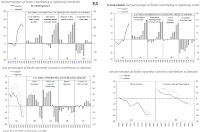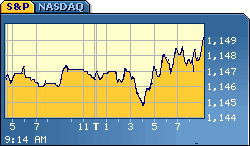This weekend the economic elite of this country meets at Jackson Hole for the Annual Economic Symposium. One year ago about the same time the topic of the gathering was "Housing, Housing Finance, and Monetary Policy", and it should surprise no one that today's topic of a speech by the chairman of the Federal Reserve, Bernanke, was about "Reducing Systemic Risk". In the introduction to his remarks he said:
"Although we have seen improved functioning in some markets, the financial storm that reached gale force some weeks before our last meeting here in Jackson Hole has not yet subsided, and its effects on the broader economy are becoming apparent in the form of softening economic activity and rising unemployment."
The "financial storm" that swept over the country about 12 month ago is still crippling the financial services industry and the debate is now raging whether its consequences will turn out to be largley inflationary or deflationary for the economy. The recent contraction in U.S. M3 money supply, the sell off in oil and gold togehter with a significant strenghtening in the U.S. dollar are rightly interpreted as a sign that deflationary forces are winning. At least until this dynamic changes again inflation as the primary concern for market participants and policy-makers is off the table. Sure enough in his speech Bernanke included the decline in commodity prices and increased stability of the dollar as encouraging signs for the future, but to be fair with oil in the tripple digits those prices are still dangerously elevated.
By taking all this different economic currents into account I can not help but ask is it really that simple as Mr. Bernanke wants us to believe when he attributed "softening economic activity and rising unemployment" to the crisis in the financial services industry? We can only speculate about the reasons but it is true that M3 money supply, the broadest measure of money stock in the U.S., has contracted significantly from 16% to 2% in the last three month. At the same time M1 and M2 are still robust. In this context it is worth noting that these measures are notoriously volatile and it should surprise no one to see M3 jumping back up in the months ahead. If this dynamic of slumping money supply continues we of course would have a strong reason to be worried, but for now the simple recall of helicopter Ben can help soothe our nerves.
A simple look at the data for assets and liabilities of commercial banks in the United States, compiled by the Federal Reserve Bank of St.Louis, paints a completely different picture. The latest data for Commercial and Industrial loans of weekly reporting by large commercial banks are still growing at 15% in August compared to last year (see chart). Consumer loans are also up 9%. Real estate loans are only up 5% and trending lower as a result of the complete failure of the secondary mortgage market.
click to enlarge
The situation is similar in Europe. According to the President of the ECB, Jean-Claude Trichet, in his latest statement the expansion of bank credit to non-financial corporations thus far remains very robust at 13.6% compared to last year only slightly lower than the 14.2% in the previous month. Loans for households and not surprisingly for house purchase have significantly slowed down according to the ECB. Trichet concludes:
"But, if everything is taken into account, the dynamism of loans to non-financial corporations has given us an overall level of lending to the private sector that is still very dynamic and I would say again that, in that domain too, we have to be respectful and pragmatic and will have to see what the facts and the figures are."
This is the key point: to be respectful and pragmatic. For macroeconomic decision making acting on facts and figures must always be preferred over a simple hunch about the outlook for the economy. Bernanke adds insult to injury when he pads himslef on the back by apperently linking softening economic activity and rising unemployment to gale force winds of the financial storm without delivering the facts.
How difficult it is to maneuver the dangerous waters of macroeconomics can be seen from the example of China where for years the government has tried to prevent overheating of their economy and now is confronted with dangerously rising CPI inflation. Only recently has the government switched back from concerns about infaltion to growth, but this decision is faced with critizism. Michael Pettis, economics professor at Peking University's Guanghua School of Management and writer of the financial blog China Fiancial Markets, worries about the transmission mechanism from high PPI inflation to rising CPI inflation.
A recent surge of fixed assets investment in July (27.3% for the first seven months of 2008) suggests a future surge in industrial production. Faced with a slowdown in global demand this would result in an oversupply of manufactured goods in China which would put downward pressure on prices. Hence the reduction in CPI inflation might be sustainable even with last months' jump in PPI inflation. But Mr. Pettis confesses:
"But I have to confess that I have a problem – perhaps instinctual – with this line of reasoning. It is true that an excess of manufactured goods should put downward pressure on prices of those goods – or at least limit the ability of producers to raise prices – but is this enough to eliminate inflation?"
He argues that excess money growth created access demand and this still must have an impact on the average price level. This could be seen in an increase in the price of food, service sector and/or in the price of manufactured goods that are not in oversupply. The only way for inflation to disappear would be a sudden collapse in money supply caused by rising bankruptcies which put pressure on the Chinese banking system to hoard cash and stop lending. Pettis concludes:
"Unfortunately none of this makes prediction easy, but I think there is one prediction I can safely make: so many years of wild money growth must result in an adjustment and this adjustment is not going to be easy."
Just how difficult this adjustment process can possibly be is illustrated by the CPI inflation rate in the U.S. from 1960 to 1980 (see chart). This period was plagued by four major inflation spikes, one bigger than the other. The chart also reveals something else, namely how wrong policy decicions can have a devastating impact on macroeconomic developments. Thirty-seven years ago in August 1971 President Nixon imposed wage and price controls to combat rising inflation. Inflation reached a temporary peak of 6.19% in 1971 Q1, and had been declining when Nixon imposed the controls in the middle of Q3 (5.46% and 4.26% over Q2 and Q3). It continued to decline thereafter for several more months, reaching a low of 2.18% in 1972 Q2, before reversing course and marching upwards over the next two years to hit a second temporary peak of 12.38% during the third quarter of 1974. Two more spikes followed making the seventies the worst economic period after the Great Depression.
click to enlarge
source: Reducing Systemic Risk Chairman
Ben S. Bernanke Annual Economic Symposium, Jackson Hole, Wyoming, August 22, 2008 http://www.federalreserve.gov/newsevents/speech/bernanke20080822a.htm
source: Introductory statement with Q&A
Jean-Claude Trichet, President of the ECB, Frankfurt am Main, 7 August 2008 http://www.ecb.int/press/pressconf/2008/html/is080807.en.html
source: Anniversary of Nixon’s price controls
By Michael Pettis, China fianncial markets http://piaohaoreport.sampasite.com/china-financial-markets/blog/Anniversary-of-Nixon2019s-price.htm
read also: U.S. Broad money M3 in sharp contraction in July 2008
Tuesday, August 19, 2008 http://manonthestreet64.blogspot.com/2008/08/us-broad-money-m3-in-sharp-contraction.html






























